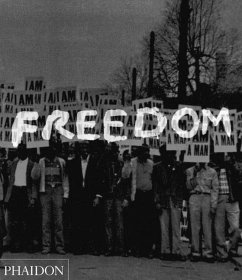This momentous volume chronicles a photographic history of the African American struggle for freedom, combining a unique assimilation of rare images with thought-provoking scholarly analysis. Although the civil rights movement in America is conventionally identified with the period between 1954 and 1968 (from 17 May 17 1954 when the Supreme Court outlawed segregation in public schools, through to the assassination of Martin Luther King, Jr on 4 April, 1968), the struggle actually began long before that.
Protests against slavery in American colonies were as far back as the seventeenth century, though it was not until the mid-nineteenth century that the resistance built momentum. This photographic journey of the African American struggle for equality begins with abolitionists like Harriet Tubman, who after escaping slavery in 1849 helped others to freedom, and continues to the twenty-first century.
Freedom chronicles, with profound sensitivity and acute attention to detail, the battle to eradicate slavery throughout the Civil War (1815). Accordingly, it traces the evolution of the dual legacy of slavery - segregation and racism - after its official prohibition. The struggle for equal rights involved countless small acts of personal bravery and sweeping proclamations of legal and moral import. Its history is the stuff of of hope and despair, vigilance and violence - realized in an arena of economics, politics and war. It engages black and white, the heroes and the unheard, public acts of protest and private moments of introspection in a world that is unforeseeably challenging.
This book comprises a passionate and poignant celebration of this historical struggle as a gradual phenomenon, substantiating incisive academic discourse with previously unpublished photographs of iconic status.
Protests against slavery in American colonies were as far back as the seventeenth century, though it was not until the mid-nineteenth century that the resistance built momentum. This photographic journey of the African American struggle for equality begins with abolitionists like Harriet Tubman, who after escaping slavery in 1849 helped others to freedom, and continues to the twenty-first century.
Freedom chronicles, with profound sensitivity and acute attention to detail, the battle to eradicate slavery throughout the Civil War (1815). Accordingly, it traces the evolution of the dual legacy of slavery - segregation and racism - after its official prohibition. The struggle for equal rights involved countless small acts of personal bravery and sweeping proclamations of legal and moral import. Its history is the stuff of of hope and despair, vigilance and violence - realized in an arena of economics, politics and war. It engages black and white, the heroes and the unheard, public acts of protest and private moments of introspection in a world that is unforeseeably challenging.
This book comprises a passionate and poignant celebration of this historical struggle as a gradual phenomenon, substantiating incisive academic discourse with previously unpublished photographs of iconic status.
Perlentaucher-Notiz zur TAZ-Rezension
Der über 500 Seiten starke Bildband "Freedom" hat Rezensentin Julia Große vollauf überzeugt. In chronologisch unterteilten Kapiteln mit "fundierten" einleitenden Texten sowie Erklärungen zu jedem der über 600 Fotografien zeichnet der Band nach Darstellung Großes nicht nur die komplexe Geschichte des afroamerikanischen Kampfes um Gleichberechtigung nach, sondern auch das Herausbilden einer eigenen Kultur und eigener Lebensentwürfe. Auch der Beginn der Rassentrennung und der Ausbildung des weißen Rassismus wird dokumentiert: Die Fotografien zu damals gängigen Lynchpraktiken, Ende des 19. bis in die ersten zwei Dekaden des 20. Jahrhunderts, sind für Große "in ihrer Grausamkeit kaum zu ertragen". Die größte Aufmerksamkeit widmet der Band dem Zeitraum des Civil Rights Movements und der Entwicklung der Black-Power-Bewegung. Große hebt diesbezüglich hervor, dass es den Autoren auch hier gelingt, dieses Kapitel afroamerikanischer Historie vor einer bloßen Reduzierung auf den schillernden Begriff der Black Power zu bewahren.
© Perlentaucher Medien GmbH
© Perlentaucher Medien GmbH
'Freedom is a wonderful resource thanks to the sheer depth of information ... leaving readers with a sense of how far the country has come as well as how far it might go in matters of civil rights, race relations and mutual understanding.' (USA Today)
'An epic undertaking that pulls together imagery from the few extant daguerreotypes of African American abolitionists and slaves through the shattering images made during the civil rights movement.' (American Photo)
'An epic undertaking that pulls together imagery from the few extant daguerreotypes of African American abolitionists and slaves through the shattering images made during the civil rights movement.' (American Photo)
'Freedom is a wonderful resource thanks to the sheer depth of information ... leaving readers with a sense of how far the country has come as well as how far it might go in matters of civil rights, race relations and mutual understanding.' (USA Today)
'An epic undertaking that pulls together imagery from the few extant daguerreotypes of African American abolitionists and slaves through the shattering images made during the civil rights movement.' (American Photo)
'An epic undertaking that pulls together imagery from the few extant daguerreotypes of African American abolitionists and slaves through the shattering images made during the civil rights movement.' (American Photo)

